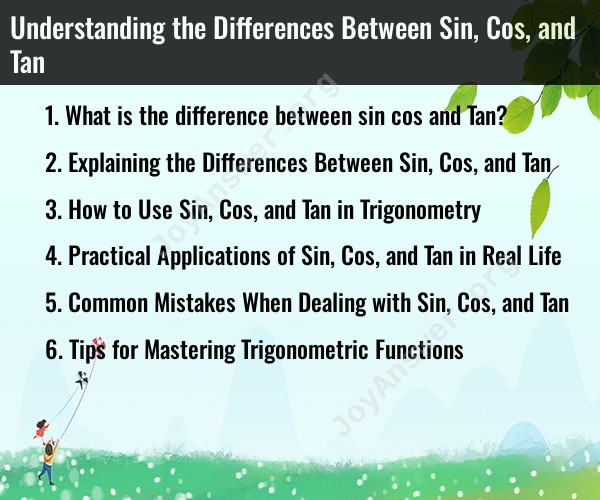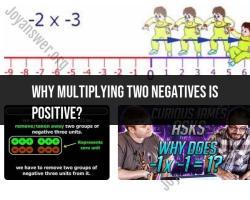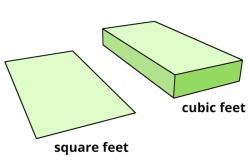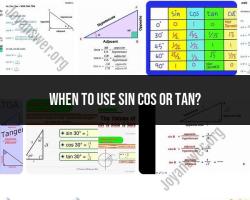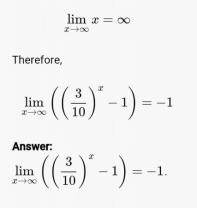What is the difference between sin cos and Tan?
Sine (sin), cosine (cos), and tangent (tan) are three fundamental trigonometric functions used in geometry, mathematics, and various scientific and engineering fields to relate angles in a right triangle to the ratios of the lengths of its sides. Here are the key differences between these trigonometric functions:
Sine (sin):
- The sine function (sin) is defined as the ratio of the length of the side opposite an angle to the length of the hypotenuse in a right triangle.
- Mathematically, sin(θ) = (opposite side) / (hypotenuse).
- Sin is a periodic function with a range of values between -1 and 1.
- Sin relates the vertical component of the triangle to its hypotenuse.
Cosine (cos):
- The cosine function (cos) is defined as the ratio of the length of the side adjacent to an angle to the length of the hypotenuse in a right triangle.
- Mathematically, cos(θ) = (adjacent side) / (hypotenuse).
- Cos is also a periodic function with values between -1 and 1.
- Cosine relates the horizontal component of the triangle to its hypotenuse.
Tangent (tan):
- The tangent function (tan) is defined as the ratio of the length of the side opposite an angle to the length of the side adjacent to that angle in a right triangle.
- Mathematically, tan(θ) = (opposite side) / (adjacent side).
- Unlike sine and cosine, the tangent function does not have a limited range. It can take on any real value, including positive and negative infinity.
- Tangent represents the slope or steepness of a line when viewing it in the context of the right triangle.
In summary, the primary difference between sine, cosine, and tangent is the way they relate different sides of a right triangle to the angle of interest. Sine focuses on the vertical side and the hypotenuse, cosine focuses on the horizontal side and the hypotenuse, and tangent relates the vertical side to the horizontal side. These trigonometric functions are widely used in trigonometry, calculus, and various fields of science and engineering to solve problems involving angles and relationships between sides in right triangles.
Explaining the Differences Between Sin, Cos, and Tan
Sin, cos, and tan are the three most fundamental trigonometric functions, which are used to relate the angles of a right triangle to the ratios of its sides. They are abbreviated as sin, cos, and tan, respectively.
Sine (sin): The sine of an angle is defined as the ratio of the opposite side to the hypotenuse in a right triangle. In other words, sin θ = opposite/hypotenuse.
Cosine (cos): The cosine of an angle is defined as the ratio of the adjacent side to the hypotenuse in a right triangle. In other words, cos θ = adjacent/hypotenuse.
Tangent (tan): The tangent of an angle is defined as the ratio of the opposite side to the adjacent side in a right triangle. In other words, tan θ = opposite/adjacent.
[Image depicting the right triangle and the ratios of sides used to define sine, cosine, and tangent]
How to Use Sin, Cos, and Tan in Trigonometry
Sin, cos, and tan are used in various trigonometric calculations, including:
Solving for missing sides or angles in right triangles
Analyzing periodic phenomena, such as waves and oscillations
Representing complex numbers and performing complex number operations
Modeling real-world phenomena, such as the motion of celestial bodies or the design of bridges and buildings
Practical Applications of Sin, Cos, and Tan in Real Life
Sin, cos, and tan have a wide range of practical applications in various fields, including:
Navigation: Trigonometric functions are used to determine position, direction, and distances in navigation systems, such as GPS and satellite navigation.
Astronomy: Astronomers use trigonometric functions to calculate the positions, distances, and movements of celestial bodies.
Engineering: Engineers use trigonometric functions to design structures, analyze stresses, and calculate forces in various engineering applications.
Graphics and Animation: Trigonometric functions are used to create realistic graphics and animation in computer graphics and video games.
Music and Sound Engineering: Sound engineers use trigonometric functions to analyze and manipulate sound waves.
Common Mistakes When Dealing with Sin, Cos, and Tan
Some common mistakes when dealing with sin, cos, and tan include:
Confusing the opposite and adjacent sides: Make sure you correctly identify the opposite and adjacent sides relative to the angle you are considering.
Misusing the inverse trigonometric functions: Inverse trigonometric functions, such as arcsin, arccos, and arctan, are used to find the angle given the trigonometric ratio. Use them carefully and be aware of their limitations.
Ignoring the range of trigonometric functions: Each trigonometric function has a specific range of values it can output. Consider the range when interpreting results or solving equations.
Neglecting the signs of trigonometric functions: Trigonometric functions can be positive or negative depending on the quadrant of the angle. Pay attention to the signs in calculations and interpretations.
Tips for Mastering Trigonometric Functions
Here are some tips for mastering trigonometric functions:
Build a strong foundation in geometry: A solid understanding of geometry, particularly right triangles and their properties, is essential for grasping trigonometric concepts.
Practice regularly: Solve trigonometric problems regularly to reinforce your understanding and identify areas for improvement.
Utilize visual aids: Use diagrams, graphs, and other visual representations to help you visualize and understand trigonometric relationships.
Seek help when needed: Don't hesitate to seek help from teachers, tutors, or online resources if you encounter difficulties.
Make it relevant: Connect trigonometric concepts to real-world applications and examples to make the learning more meaningful and engaging.
